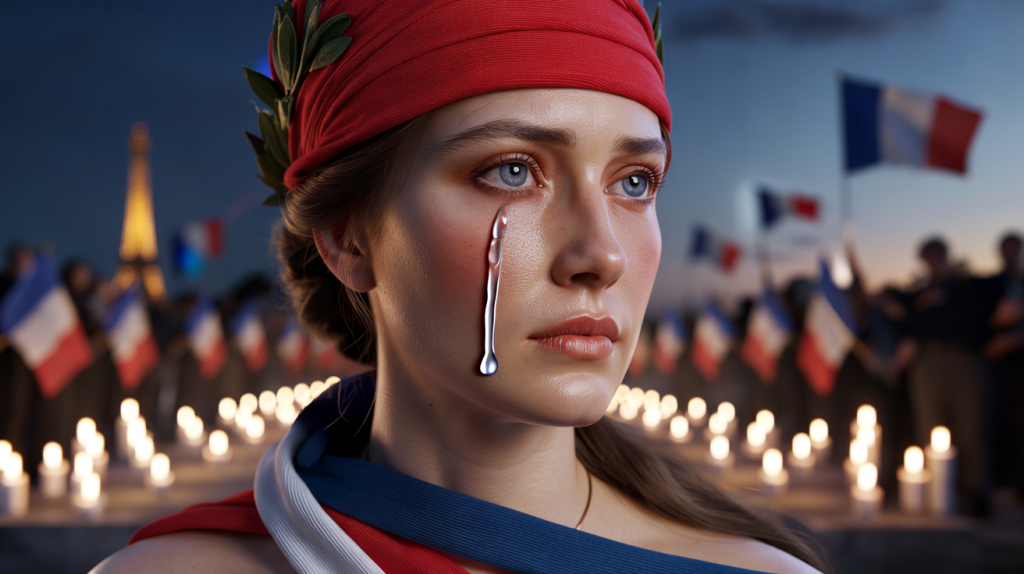Marianne en pleurs 2015, a symbol born in shock
A tear on the cheek of Marianne, the French Republic made human, became the instant shorthand for national sorrow in January and November 2015. The motif surfaced everywhere at once, from front pages to posters, as France looked for a way to say silence and solidarity at the same time.
The context is precise. On 7 January 2015, the Charlie Hebdo attack killed 12 people in Paris. Over the following days, 5 more were murdered, bringing the total to 17 according to the Interior Ministry. On 13 November 2015, coordinated attacks killed 130 people, figures confirmed by French authorities. These dates shaped the visual language of mourning, and “Marianne en pleurs” became the most legible of all signs.
Why this image mattered and how it spread
Marianne already carried a heavy load of meaning. Liberty, citizenship, resistance. In 2015, artists and editors tilted that code slightly. The Phrygian cap stayed, the tricolour stayed, but the line softened and a single tear told the rest. It read fast. It felt collective.
Newsrooms placed the crying profile in headers and illustrations. Municipalities added black crepe to their Marianne busts in town halls. Posters appeared in shop windows and on vigils. The same figure travelled from metropolitan cities to smaller communes, because the image worked without a caption. It occured within hours, not weeks, which explains why many still search “Marianne en pleurs 2015” when trying to identify a cover or a poster from that winter.
Scale matters here. On 11 January 2015, the Interior Ministry, cited by AFP, estimated 3.7 million people marched across France during unity rallies. In that immense crowd, homemade placards often borrowed the tear, sometimes paired with the tricolour or a pencil. The symbol moved from print to streets without losing its clarity.
Facts that frame the emotion
The expression “Marianne en pleurs” does not point to one single, official artwork. It names a visual theme adopted by multiple creators in 2015. Some versions were minimalist line drawings. Others borrowed from the classical bust. The shared element was the tear on the Republican face.
Two moments concentrated usage. The first followed 7 to 11 January 2015, from the attack to the mass rallies. The second followed 13 November 2015 and the national tribute days that came after. French authorities declared three days of national mourning in November. Media archives from January and November show the crying Marianne recurring across covers, posters and social media cards.
Numbers help anchor the memory. 7 January 2015 for Charlie Hebdo. 11 January 2015 for the nationwide marches estimated at 3.7 million. 13 November 2015 for the Paris attacks that killed 130. These figures appear in Interior Ministry briefings and AFP reports from those dates.
How to cite or verify a “Marianne en pleurs” visual
Search trends bring many to this keyword when they need to credit an image, clear rights for a book or simply understand where a poster came from. A few checks avoid confusion between the theme and a specific artwork.
Here is a quick method when working with archives or social posts.
- Identify the publication date: compare with the two key windows, January 2015 or mid November 2015.
- Trace the source: newspaper front pages are catalogued by the Bibliothèque nationale de France and major press agencies.
- Check authorship: artists often signed in the corner. If the image is unsigned, search by reverse image on the original resolution.
- Verify caption language: “Marianne”, “République”, and a tear are consistent clues, but avoid assuming one unique creator.
- Clear rights: editorial use and commemorative use follow different licensing rules, indicated by the outlet or the artist’s website.
A last point helps when cataloguing. Marianne is both an official emblem and a cultural figure that artists reinterpret. In 2015, the tear shifted the emblem from institution to emotion without changing its republican core. That tension explains both the reach of the image and the frequency of the query that still brings readers back to “Marianne en pleurs 2015”.
